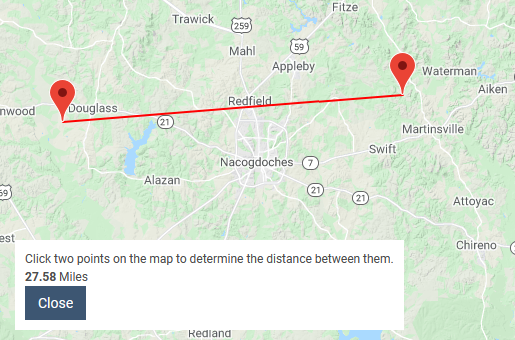Planning Maps
Planning Maps are user defined views that allow positioning custom content within a map.
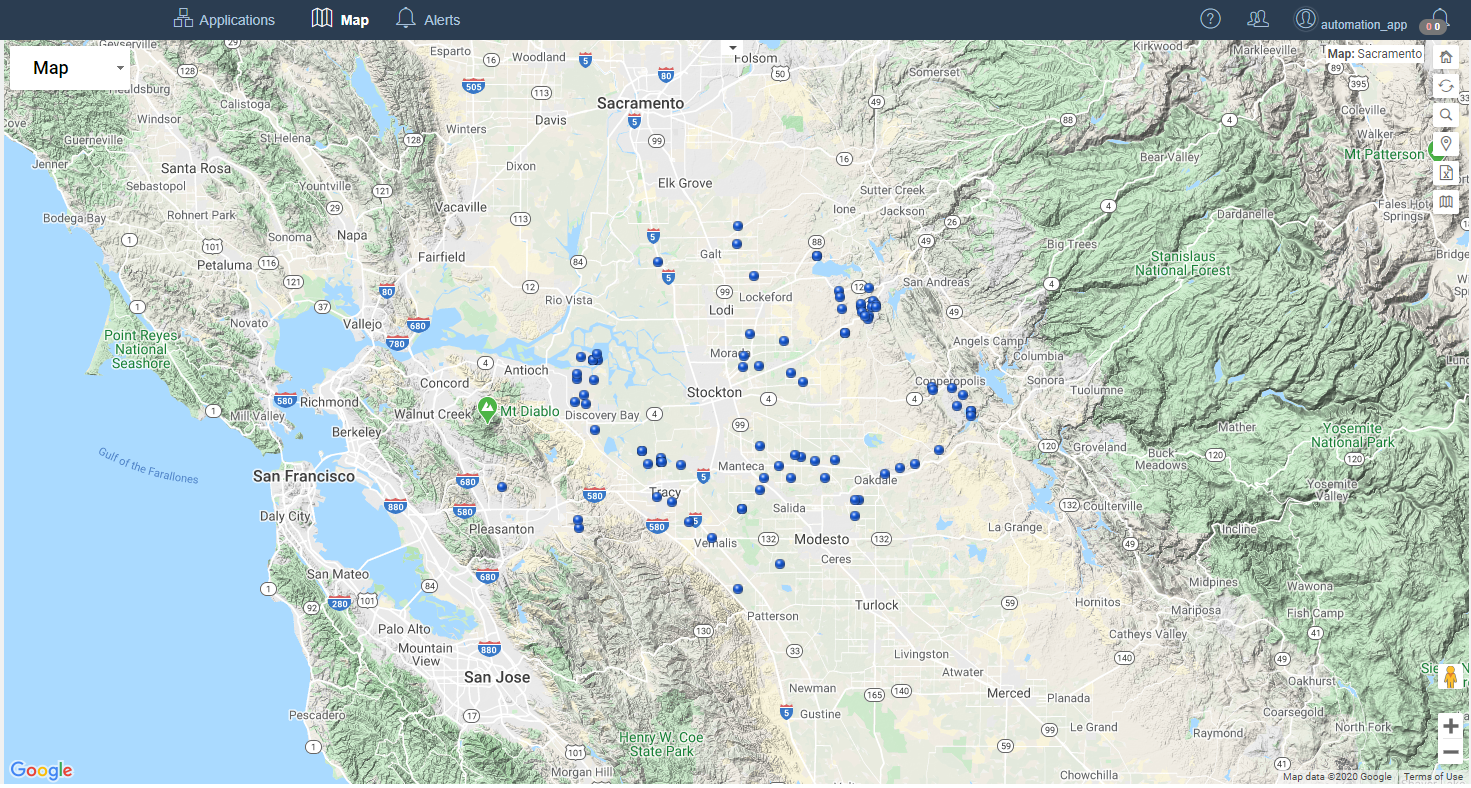
 Reset the map center and zoom
Reset the map center and zoom
 Refresh the contents of the map
Refresh the contents of the map
 Coverage: Show the map Coverage tool
Coverage: Show the map Coverage tool
 Map Planning: Create, open or manage maps
Map Planning: Create, open or manage maps
Creating Planning Maps
1. To create a map, select Create Planning Map from the Map Option button menu. This action will open a create planning maps form.
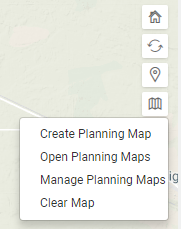
2. Enter a map name.
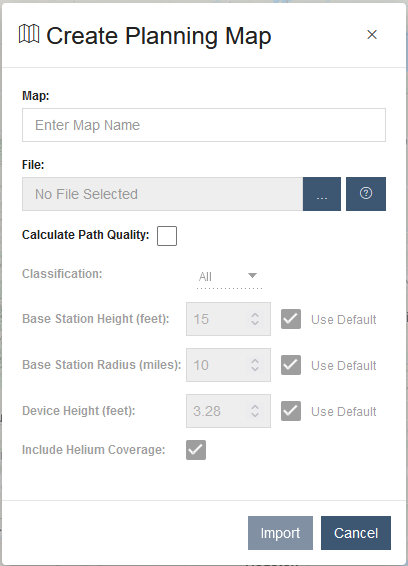
Note
Selecting  opens a dialog that displays the valid columns for the planning map. A planning map consists of multiple columns of data including latitude and longitude location information in the decimal degrees format, ex. 42.8334, -106.35946.
opens a dialog that displays the valid columns for the planning map. A planning map consists of multiple columns of data including latitude and longitude location information in the decimal degrees format, ex. 42.8334, -106.35946.
The minimum required columns for end points are latitude and longitude only. Planning maps are saved in CSV file format.

Note
By selecting the “Calculate Path Quality” entry, a path quality analysis with be performed for each endpoint location based on the projected viewshed of Base Stations in the area. Base Stations and proposed Base Stations in the imported file contribute to the path quality calculation. The Path Quality Settings for the calculation can be configured here. Also,Application Providers can view Planning Maps that contain Base Stations, but cannot add them.

3. Selecting  will open the local computer file explorer to select the desired planning map that has previously been created. For this example, the file “Customer_Location_mapversion” was selected. Click the “Import” button to import the planning map into the mapping tool.
will open the local computer file explorer to select the desired planning map that has previously been created. For this example, the file “Customer_Location_mapversion” was selected. Click the “Import” button to import the planning map into the mapping tool.
4. Selecting “Show Map” results in the mapped objects being displayed on the planning map location. This encompasses all the end point pin locations in the respective view.


Planning Map Fields
| Column | Description | Optional |
|---|---|---|
| Latitude | The latitude of the entry | |
| Longitude | The longitude of the entry | |
| Address | The address of the entry. This will be used to get the latitude and longitude if not specified. | |
| PathQuality | The path quality value associated with the entry. |  |
| Description | A description for the entry. |  |
| Type | Either Device Or Base Station (If left blank Device type will be used). |  |
| Marker | The icon ID of a marker you wish to use instead of the default one. |  |
| Radius | The range of the Base Station in miles if the type selected is Base Station. |  |
| Height | The height of the Base Station in feet if the type selected is Base Station. |  |
| PQ Bstn 1 EUI | The EUI of the Base Station that gave the best path quality results for the given row |  |
| PQ Bstn 1 pathQuality | The path quality result provided by PQ Bstn 1 in decimal percentage. |  |
| PQ Bstn 1 Distance | The distance between the entry and PQ Bstn 1 in miles. |  |
| PQ Bstn 1 Height | The height of PQ Bstn 1 in feet. |  |
| PQ Bstn 1 Azimuth | The Azimuth heading between the entry and PQ Bstn 1 in decimal degrees. |  |
| PQ Bstn 2 EUI | The EUI of the Base Station that gave the second best path quality results for the given row |  |
| PQ Bstn 2 pathQuality | The path quality result provided by PQ Bstn 2 in decimal percentage. |  |
| PQ Bstn 2 Distance | The distance between the entry and PQ Bstn 2 in miles. |  |
| PQ Bstn 2 Height | The height of PQ Bstn 2 in feet. |  |
| PQ Bstn 2 Azimuth | The Azimuth heading between the entry and PQ Bstn 2 in decimal degrees. |  |
| PQ Bstn 3 EUI | The EUI of the Base Station that gave the third best path quality results for the given row |  |
| PQ Bstn 3 pathQuality | The path quality result provided by PQ Bstn 3 in decimal percentage. |  |
| PQ Bstn 3 Distance | The distance between the entry and PQ Bstn 3 in miles. |  |
| PQ Bstn 3 Height | The height of PQ Bstn 3 in feet. |  |
| PQ Bstn 3 Azimuth | The Azimuth heading between the entry and PQ Bstn 3 in decimal degrees. |  |
Note
Application Providers can view Planning Maps that contain Base Station type objects, but cannot add them.
Exporting Planning Maps
Planning Maps can be exported through the Planning Maps table. Simply select on a row by selecting on the name field. Then click the export  button. This exports a map in the same format that it was imported so that it can be shared or re-imported. As part of the export, the best 3 Base Stations that contributed to the last Planning Map path quality calculation are included for each entry. This provides the path quality, distance, height, and Azimuth that was measured for that Base Station when compared to that map entry.
button. This exports a map in the same format that it was imported so that it can be shared or re-imported. As part of the export, the best 3 Base Stations that contributed to the last Planning Map path quality calculation are included for each entry. This provides the path quality, distance, height, and Azimuth that was measured for that Base Station when compared to that map entry.
Planning Map Marker Images
| Image | Marker ID |
|---|---|
 |
bluecircle |
 |
lightbluecircle |
 |
yellowcircle |
 |
greencircle |
 |
lightgreencircle |
 |
redcircle |
 |
pinkcircle |
 |
orangecircle |
 |
lightorangecircle |
 |
graycircle |
 |
darkgraycircle |
 |
lightgraycircle |
 |
towergreen |
 |
towerred |
 |
towerblack |
 |
towerblue |
 |
towerorange |
| --- |
Managing Planning Maps
Selecting “Manage Planning Maps” displays the planning maps summary table below.


Measuring distance
The map provides the ability to quickly measure the distance between two points on the map. Click the  button and then select "Measure Distance" from the menu to enable the feature.
button and then select "Measure Distance" from the menu to enable the feature.

Then select two points on the map and see the distance in miles between them. This disables all other clickable elements so that any two points can be selected without triggering other map features. Clicking close will remove the two markers, the line, and the distance dialog.
Coverage Tool
The Coverage Tool button launches a dialog that contains a search field for entering addresses or locations.
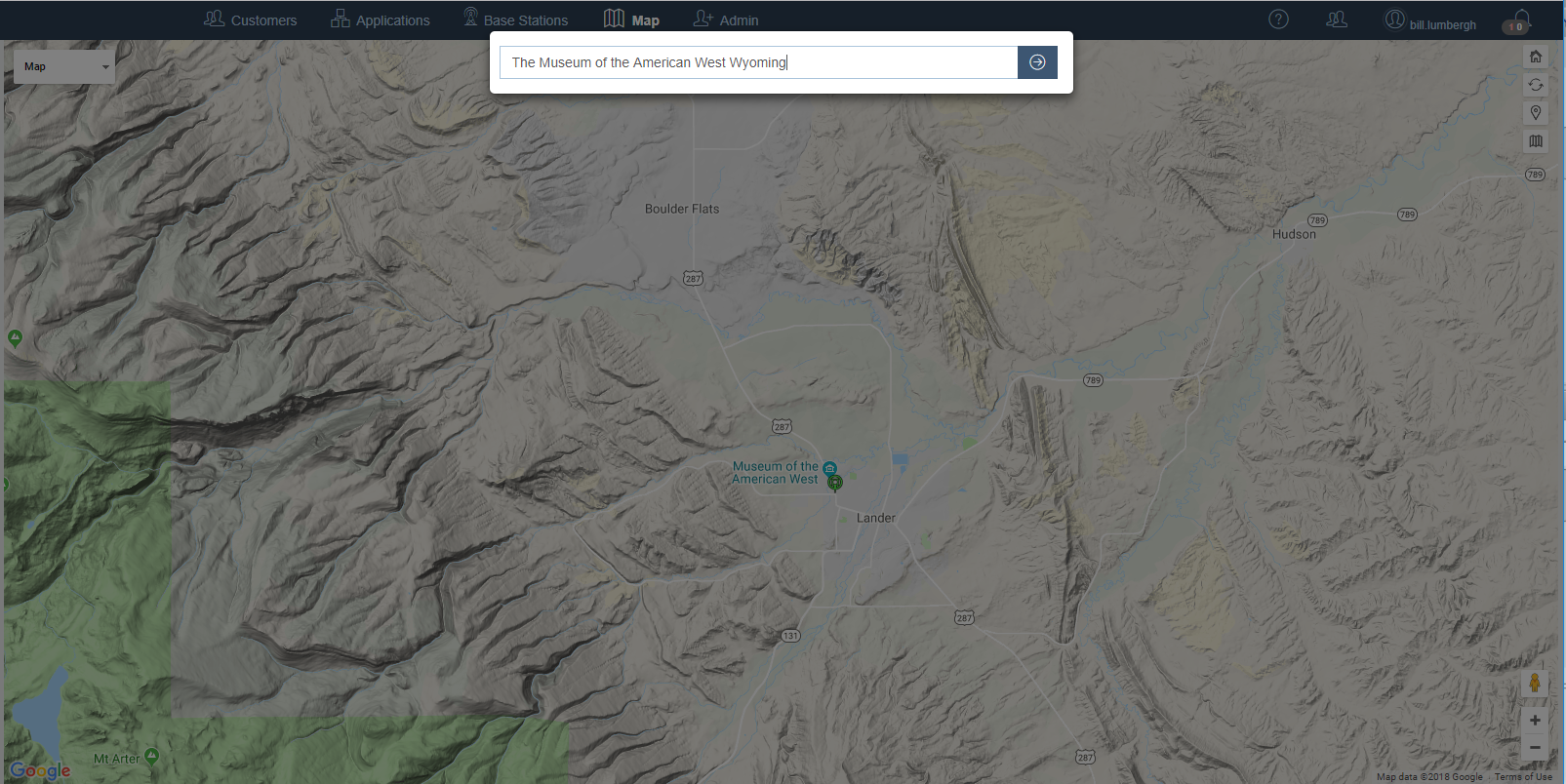
Once the search information is submitted by pressing the enter key or clicking the  icon, the map shows a pin for the location and the estimated path quality to nearby Base Stations (See Path Quality below). The green areas on the map reflect areas of high quality radio reception.
icon, the map shows a pin for the location and the estimated path quality to nearby Base Stations (See Path Quality below). The green areas on the map reflect areas of high quality radio reception.
Right-clicking on an empty area of the map provides a short cut for checking coverage. This creates a pin at the clicked location and opens the Location Information dialog. Selecting the Path Quality tab shows the estimated path quality to nearby Base Stations (See Path Quality below).
Coverage Layer
The Coverage Layer is designed to display predicted network coverage of Base Stations within a given area. The layer is comprised of all viewsheds corresponding to the Base Stations within the Map's viewport, and presented as green image overlays.
This layer is only enabled at zoom level 9 and higher and may require zooming in to view coverage, as dynamically indicated by the Map Layers icon:
 - Available
- Available
 - Unavailable
- Unavailable
Once available, activate the Coverage Layer by first clicking the 'Map Layers' button, and then checking the 'Coverage' option.
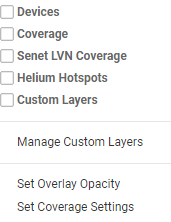
When changes in either the location focus of the Map viewport or the zoom level are detected, a refresh is required to update the Coverage Layer's presentation, as indicated by a yellow emphasis outline and motion (not shown) of the 'Refresh Map' button:

The 'Set Coverage Settings' menu shown above can be used to scope the Viewsheds included in the Coverage Layer to a specific Base Station Classification.

The Coverage Layer's opacity can be adjusted via the 'Set Overlay Opacity' option from the menu shown above.
Senet LVN Coverage and Helium Hotspot Layers
Two additional coverage layers are also available to visualize broader regional coverage, the Senet LVN Coverage layer and the Helium Hotpots layer.
Senet LVN Coverage Layer
The Senet LVN Coverage layer shows the aggregate coverage provided by all Base Stations participating in the Senet LVN. Covered areas are presented as green hexagons based on Path Quality colored according to the following table:
| Coverage Level | Color | Path Quality |
|---|---|---|
| Excellent | Dark Green | Path Quality to hexagon's center point > 75% |
| Good | Green | Path Quality to hexagon's center point > 25% and <= 75% |
| Partial | Light | Path Quality to hexagon's center point <= 25% |

Helium Hotspots Layer
The Helium Hotspots layer shows the location of known Helium Hotspots on the Map as purple hexagons. Each hexagon may include one or more Helium Hotspots within the displayed region. Path Quality calculations have the option to include Helium Extended coverage for determining whether an area is covered by the Helium Network.
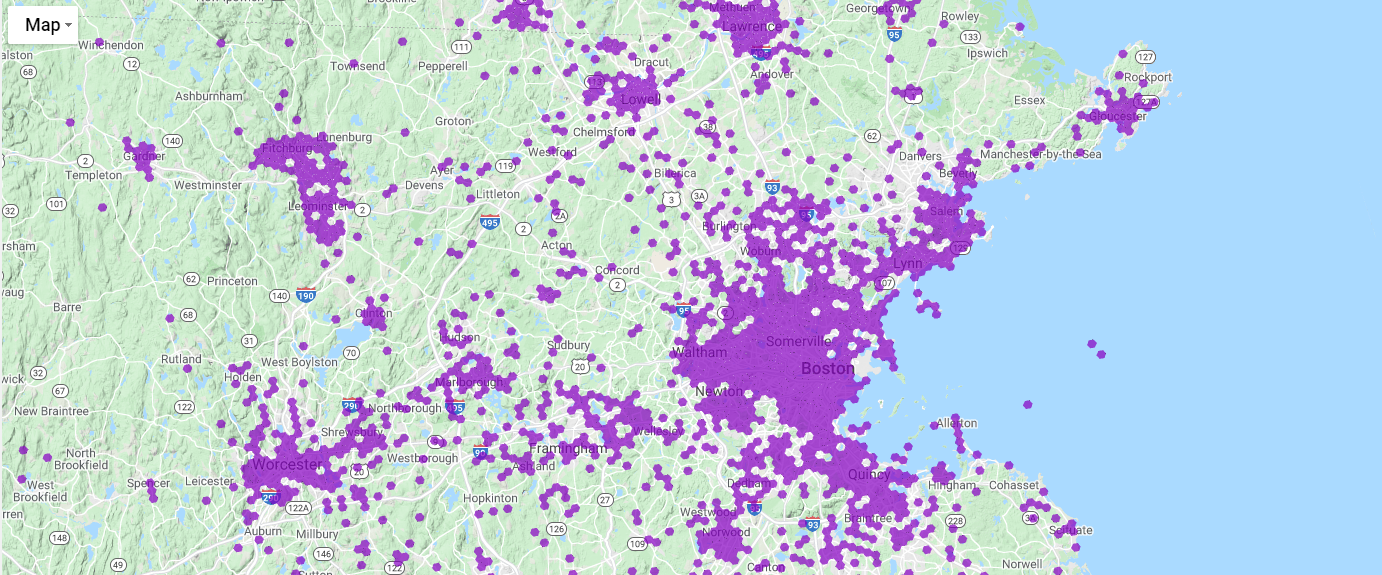
Path Quality
The path quality dialog shown in the lower left of the map, shows detailed information about the distance between the search location and the Base Station and reception quality expressed as a percentage. This percentage reflects the Fresnel clearance (line of site) between two points. This calculation uses an elevation database to determine how obstructions interfere with the line of site. Note: The zoom level of the map can be adjusted after the search to view the results with a different perspective. This may be required to see in-range Base Stations that are outside of the initial result view.
The pin plot for the selected location will also display a vector to each Base Station indicating the direction of coverage.
The following are different examples of line of sight path quality calculations:

And this is how the path quality results are displayed in the map:

Path Quality Settings
Senet provides the ability to configure how path quality is calculated by allowing override of key inputs as well as control over which type of Base Station it is calculated for. Inputs overrides include Base Station height (feet) and radius (miles) , Device height (feet) and whether or not to include Helium Extended coverage. The Classification filter constrains which types of Base Stations the calculation is performed for. Customized settings are persisted across calculations to ensure a consistent planning experience.
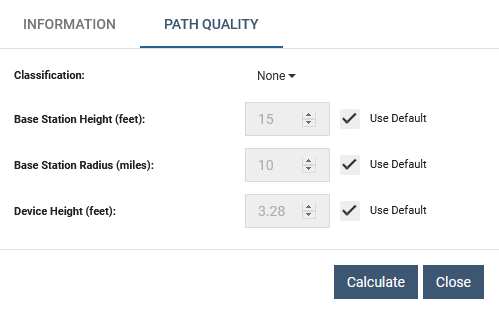
Multiple Classifications

Include Helium Coverage

Path Quality Results

Note
Path Quality will include a count of the nearby Helium hotspots within range of the target location. Hotspot name, distance, and azimuth information are not included, because this is an aggregate count and not attributed to just one hotspot.
Path Quality Marker Colors
Path Quality Markers are generated for Planning Map entries that do not have a pre-defined marker. The markers are generated if the Calculate Path Quality check-box is selected during map creation or initiating a path quality calculation from the table.
| Color | Meaning |
|---|---|
 |
No coverage or path quality not calculated |
 |
Senet path quality between 0% and 25% |
 |
Senet path quality between 25% and 50% |
 |
Senet path quality between 50% and 75% |
 |
Senet path quality between 75% and 100% |
If Helium hotspots are included in the Path Quality calculations, the generated markers include a purple dot as shown here:
| Color | Meaning |
|---|---|
 |
Senet path quality between 0% and 25%; Helium Hotspot(s) present |
 |
Senet path quality between 25% and 50%; Helium Hotspot(s) present |
 |
Senet path quality between 50% and 75%; Helium Hotspot(s) present |
 |
Senet path quality between 75% and 100%; Helium Hotspot(s) present |
 |
No Senet coverage; Helium Hotspot(s) present |

